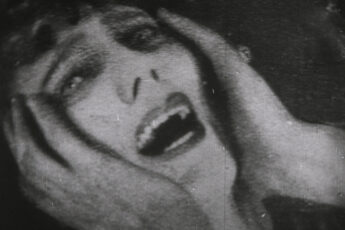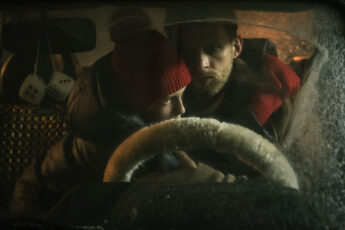How Poppies Persist and Prevail
Marta Popivoda’s Landscapes of Resistance (Pejzaži otpora, 2021)
Vol. 112 (February 2021) by Melina Tzamtzi
In the very beginning of the film, as we see a close-up shot of a field of red poppies, we hear the lyrics of an acapella song which ends with the line “All that remains, are poppies red”. The poppy, the fragile flower with the dark-red petals, has been employed symbolically in many ways, due mostly to its color whose tone is similar to that of blood. I remember being a little girl, walking in the Greek fields somewhere around Easter, and being told to watch out for the poppies and not to step upon them, as they are supposed to literally “be” the blood of Jesus. Another poppy-memory comes from the 1939 Hollywood classic The Wizard of Oz. There is the scene where Dorothy struggles not to fall asleep in the Poppy field. The poppy has always been associated with death and sleep (perhaps because one can extract opium from the plant) but it has also been linked to remembrance and to hope after the Spring of 1915: in Western Europe, while many landscapes had turned to mud due to the war, bright red poppies still managed to blossom in the Flanders Fields in Belgium. The poppy field close-up that opens the Landscapes of Resistance is linked to the bloody European story of another war, the story, not at all fictional and highly pertinent to our collective memory, of those who fought Nazism.
Filmmaker Marta Popidova met Sonja Vujanović, the documentary’s main character, through her longtime partner (and co-writer of the script) Anna Vujanović, Sonja’s grand-niece. Sonja, who was born in Petka, a village near Valjevo in Yugoslavia, is an Auschwitz survivor and a fervent ex-partisan who organized herself politically from a very young age. Marta, who was a film student and politically active in the independent cultural scene of Belgrade when they first met, was captivated by Sonja’s life events and even more by her story-telling. Thus, she felt the need to eventually make a documentary with her. As time went by and Europe’s capitalist reality became graver and graver, Marta felt the urgency to complete this documentary that was already 10 years in the works “in order to remind young people that conscious political decisions still and always have to be made, about how we organize and how we eventually resist”.
Landscapes of Resistance is a portrait of a woman for whom resistance was a way of being. It is also an essay on how to produce a political landscape, or alternatively on how memory is engraved in the material world in order to align the past with the present. To accomplish this, Popidova made the aesthetic choice of relying on the one hand on Sonja’s verbal images, and on the other hand on the Serbian forests where the actual story took place. The result of that is a powerful documentary with a form of narration that plays on contradiction: Sonja’s intense chronicle of resistance is accompanied by the calm and soft images of the chosen landscapes in present time. Popidova matches these opposites (a narrative harshness with an optical softness) and accomplishes her purpose to intertwine the past and the present. At the same time, she delivers her political statement: phenomenal calmness doesn’t mean that agony and constant vigilance may not or should not lie beneath it.
The documentary unfolds by following the linear storytelling of Sonja. We watch her at the age of 97. She has turned into a very old, fragile lady that needs help to take care of her basic needs, but still manages to sit on her armchair with a smile on her face, looking forward to dive into her memory and narrate her partisan days. Soon we realize that her fragility is only corporal: her words hit straight and powerful and her humor indicates the sharpness of her mind. “I was a communist even before I became a partisan!” she states, as she recalls her high-school years when she was expelled for her ideology because she was already reading “progressive literature”. She narrates how she and Sava, her companion and also secretary of the Yugoslav Communist Youth, escaped Belgrade and managed to get married by a Communist priest with the help of their “connections” even though they were underage at the time. When Sava died while on a mission, Sonja continued to orchestrate missions in the Serbian woods and take part in them, and encouraged the village women to get organized and fight.
Landscapes of Resistance is undoubtedly a feminist film. As Popidova underlines, Sonja’s story-telling is extremely important because it gives us an actual look at the female perspective of the war, which is firstly still underrepresented and secondly utterly differs from a male one. A female perspective is focused not on the events but on how the people were feeling and organizing. Indeed, Sonja’s story of her days as a partisan has a human touch that puts flesh and bones in the characters and triggers our empathy. She narrates how she sensed that it was the last time she was seeing her husband alive or how her friend (and international acclaimed Communist hero) Stjepan Filipović encouraged her to overcome her partner’s death and keep fighting. Sava’s death was a crucial moment for her resistance. Having faced this tragic loss, in a way she became immune to death, at least to its symbolic connotation. Dying wasn’t an obstacle for her, and taking part in a constant and consistent struggle, not as a reaction but as a way of being, filled her with purpose. The film’s narrative is full of moments that focus on the bravery, determination and lucidity that characterized her, for example on the moment when she was tormented in the Gestapo basements in Belgrade with a horsewhip with wires and yet refused to give away any information, or when she was immediately recruited to the resistance team in Auschwitz, where she hid away knives and conspired with other women to fight the SS guards.
Those reminiscences construct the lyrical storytelling that creates haunting images and form the conceptual landscape of the documentary (one of the strongest moments is when she describes the women’s bodies in the camps like mummies walking straight). Moreover, everything else that is depicted in the film can be identified as a landscape of resistance. Most of the shots are close-ups of different kinds of textures, manufactured either by humans or by nature: we see the hair of Sonja’s cat and her old fingers caressing it, many shots of her skin, of the colorful blankets or the patterns of the old-fashioned tissues hanging from the walls. Those soft images are shown in an intimate, affectionate way and have a meditating effect, almost purifying: something like hope is entering our skin. Those close-ups can be perceived as the documentary’s way of respecting, honoring and caressing its content, the protagonist and her storytelling. Watching this film in current times, as we are forced to reevaluate the importance of intimacy, human contact and touch, a cinematic experience this intimate and respectful is especially moving. Herein, another political statement is made: that “the simple things” take care of the self and that the rest must not be taken for granted.
In the same respectful way, the landscapes are being depicted with a dose of curiosity that creates a differentiation between nature and the human element and recognizes the first as an independent entity that encloses the past in its own way of being. Peculiar wooden objects are shown in the woods, mysterious motifs engraved in tree bunches, or different kinds of foliage tangled on the housetop. Those nature shots also constitute the director’s way of paying tribute to the movement of cubism and to the one of constructivism which was the leftist art of Sonja’s time. We watch chosen details of the actual locations of Sonja’s journey of resistance being transformed into monuments; there are the naked tree trunks on the way to Auschwitz, the lined chimneys of the concentration camp. Another landscape is made up of the pages of Marta’s diary that keep popping up in the documentary and that refer to the director’s personal political activist engagement as well as her disappointment with the current political state of Europe. Her parallelism is not made to equate active communism with “cultural Marxism” (as she characterizes the current leftist ideology) but to underline that forms of fascism still occur “in the dead ends of Europe”, demanding our political engagement.
The ultimate landscape of resistance is shown in the end. It is a tattoo engraved into the skin with blue haunting ink, the number 82298. Although until now Sonja’s verbal images can strike us as another story from afar that enables our empathy but cannot hurt us, the appearance of the tattoo makes this illusion vanish. As we are forced to look to the only real footage in the film, the word and the image finally align as the past penetrates the present and we are invited to take part in a reality check: humanity has already shown its evil face in the form of Nazism, a face that always lurks in the shadows since then, so that we need to be constantly vigilant. This moment of the documentary is especially powerful because of the temporal alignment. Sonja was a grandmother, a girlfriend, a comrade, a cat-owner, a wife, a student, a partisan, but also a number, the number 82298. In a particular space-time conjuncture, people were nothing more than numbers. In the documentary’s ending we cannot help but be aligned with its final words. We must be partisans. There is no alternative, and our frailty does not speak against this. Like poppies, we can ultimately persist and prevail.




Leave a Comment